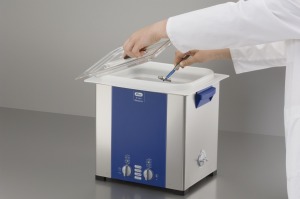Using Acid in an Ultrasonic Cleaner
There are a wide variety of ultrasonic cleaning solutions on the market. Each of those cleaning liquids are formulated for specific cleaning operations in an ultrasonic cleaner. These solutions are generally classified as alkaline (high pH), neutral, or acidic (low pH). Most acidic ultrasonic cleaning solution concentrates are biodegradable and when diluted according to instructions can be used in stainless steel ultrasonic cleaning tanks such as the Elmasonic ultrasonic cleaners available from Tovatech.
Protecting Staff and Ultrasonic Cleaner Tanks from Highly Acidic Baths

If the cleaning solution needed for your application is one of the corrosive low pH solutions such as nitric, sulfuric, formic, or hydrofluoric acid, be sure to include proper protection. Without protection, these acidic solutions can be harmful to the operator, your ultrasonic cleaner, and the items being cleaned.
Solving this problem is twofold and, while relatively simple, requires a procedure that must be part of your company’s operations manual.
- The first is being certain you have an air handling system that draws off fumes emanated during the ultrasonic cleaning cycle.
- The second is protecting the tank itself from the acid.
Protect the stainless steel ultrasonic cleaning tank by using an acid-resistant plastic tub insert to hold the acidic cleaning solution. Acid resistant tubs, available from Tovatech, are sized according to the capacity of the ultrasonic cleaner tank used.
5 Steps to Ultrasonic Cleaning with Acidic Solutions
The steps below are recommendations and may not guarantee safety. Please consult your company resources regarding the use of corrosive liquids prior to attempting to use with your ultrasonic cleaner.
- The bottom of the plastic tub must not be in contact with the bottom of the stainless steel tank and there must be space between the side walls of the two containers. A properly sized tub will solve this.
- Add water to the ultrasonic tank so that the tub is in contact with water when positioned in the tank. The rim flange of the tub rests on the rim of the tank. Never turn on the ultrasonic power when the tank is dry.
- Place a lid on the tub and turn on the ultrasonic cleaner to allow the water and acidic cleaning solution to degas. Some cleaners have an auto degas feature to remove cavitation inhibiting air in the water and solution. Cavitation action by the ultrasonic transducers will pass through the water, through the plastic tub and into the cleaning solution.
- Objects to be cleaned should be carefully positioned on the bottom of the tub or in baskets then lowered into the cleaning solution. You will get optimum cleaning if they do not contact each other. Set the heater and timer as appropriate for parts being cleaned.
- At the end of the cleaning cycle carefully remove and rinse the parts.
Disposal of spent cleaning solutions should be in accordance with local regulations.
Remember that the plastic tub insert absorbs some of the ultrasonic power. Be sure your take this into account when selecting the power for your ultrasonic cleaner.
Ensure You Have the Right Equipment for Using Acid in an Ultrasonic Cleaner
Contact the ultrasonic cleaning professionals at Tovatech for expert advice on cleaning equipment, solutions and processes.
